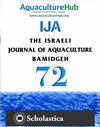Effect of replacement of fishmeal by soybean products with attractants supplementation on the growth performance, feed utilization, body composition, plasma physiological responses and hepatic antioxidant abilities of juvenile golden pompano Trachinotus ovatus
IF 0.5
4区 农林科学
Q4 FISHERIES
引用次数: 0
Abstract
A feeding experiment was carried out to develop a practical diet with low fishmeal for juvenile golden pompano (Trachinotus ovatus) by substituting fishmeal protein with soybean products mixture. Six isocaloric (17.6 KJ g−1) diets were designed by replacing 0 (FM100), 5 (FM95), 10 (FM90), 15 (FM85), 20 (FM80), and 25% (FM75) of the fishmeal with soybean products mixture (SPM) (soybean meal and soybean protein concentrate). The experiment diets were supplemented with 1.5%, 3%, 4.5%, 6% and 7.5% squid paste as attractants or palatability enhancer. The experimental fish (6.9 g) were cultured in sea cages (1.0 m × 1.0 m × 1.5 m) with 25 fish in each cage. Fish were fed the corresponding experimental diets to satiation twice daily for 8 weeks. At the end of the feeding experiment, no differences were found in the final weight and weight gain (WG) of fish fed FM100, FM85, FM80, and FM75 diets (P > 0.05). The WG was significantly (P < 0.05) better in the fish-fed FM95 diet compared to FM100 and FM75 diets. FCR in diet FM95 and FM90 was significantly (P < 0.05) than that of FM80 and FM75, but these values were not significantly different from those in other treatments. Although the condition factor value in diets FM90, FM85, and FM80 was significantly (P < 0.05) higher than that of FM100, these values were not significantly different from the rest of the other groups. There was no statistical difference in SGR, FR, VSI, and survival rates among different dietary treatments. The plasma AST activity was significantly lower in fish fed FM90 diet compared to fish fed with control, FM85, FM80, and FM75 (P < 0.05). There was no significant difference in plasma AST among all dietary treatments except FM95 and FM90. In contrast, the plasma AKP activity showed the opposite trend. Compared with the control, the fish-fed FM80 and FM75 diets had significantly decreased plasma cholesterol, triglyceride total protein, albumin, and globulin level (P < 0.05) while significantly increasing plasma COR levels (P < 0.05). There was no significant difference in ALT, Urea and glucose values among all treatments. No statistical difference was observed among the FM100, FM80, and FM75 treatments for those of plasma LYZ activity, C3, and C4 levels. The hepatic T-AOC and SOD activities were significantly increased in fish fed the FM90 diet (P < 0.05) compared to those in fish fed with FM100 diet. According to the current experiment, it can be concluded that SPM supplemented with SP could partially substitute fishmeal (25%) for juvenile golden pompano without any adverse symptoms.豆制品替代鱼粉并添加引诱剂对卵形鲳鲹幼鱼生长性能、饲料利用、体成分、血浆生理反应和肝脏抗氧化能力的影响
采用豆制品混合物替代鱼粉蛋白,研制了一种实用的低鱼粉饲料。用豆粕和大豆浓缩蛋白混合物(SPM)替代鱼粉含量为0 (FM100)、5 (FM95)、10 (FM90)、15 (FM85)、20 (FM80)和25% (FM75)的等热量饲料(17.6 KJ g−1)。在试验饲粮中分别添加1.5%、3%、4.5%、6%和7.5%的鱿鱼膏作为引诱剂或增味剂。实验鱼(6.9 g)在1.0 m × 1.0 m × 1.5 m的海网箱中养殖,每个网箱25条鱼。饲喂相应试验饲料至饱腹,每天2次,连续8周。饲喂试验结束时,FM100、FM85、FM80和FM75饲料对鱼的末重和增重均无显著差异(P > 0.05)。与FM100和FM75饲料相比,FM95饲料的WG显著(P < 0.05)提高。饲粮FM95和FM90的FCR显著高于FM80和FM75 (P < 0.05),但与其他处理差异不显著。饲料FM90、FM85和FM80的条件因子值显著(P < 0.05)高于饲料FM100,但与其他各组差异不显著。不同饮食处理的SGR、FR、VSI和生存率无统计学差异。FM90组血浆AST活性显著低于对照组、FM85、FM80和FM75组(P < 0.05)。除FM95和FM90外,各饲粮处理间血浆AST水平无显著差异。血浆AKP活性则呈现相反的趋势。与对照组相比,FM80和FM75饲料显著降低了血浆胆固醇、甘油三酯总蛋白、白蛋白和球蛋白水平(P < 0.05),显著提高了血浆COR水平(P < 0.05)。各组间ALT、尿素、葡萄糖值差异无统计学意义。FM100、FM80和FM75处理的血浆LYZ活性、C3和C4水平无统计学差异。与FM100组相比,FM90组肝脏T-AOC和SOD活性显著升高(P < 0.05)。根据本试验结果,SPM中添加SP可部分替代25%的鱼粉,且无不良反应。
本文章由计算机程序翻译,如有差异,请以英文原文为准。
求助全文
约1分钟内获得全文
求助全文
来源期刊
CiteScore
0.90
自引率
16.70%
发文量
49
审稿时长
3 months
期刊介绍:
Information not localized

 求助内容:
求助内容: 应助结果提醒方式:
应助结果提醒方式:


